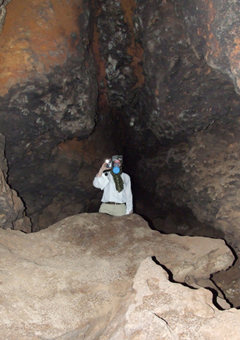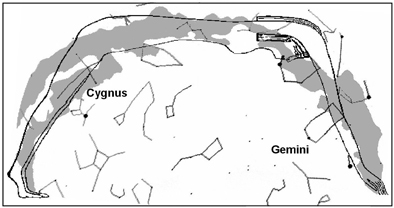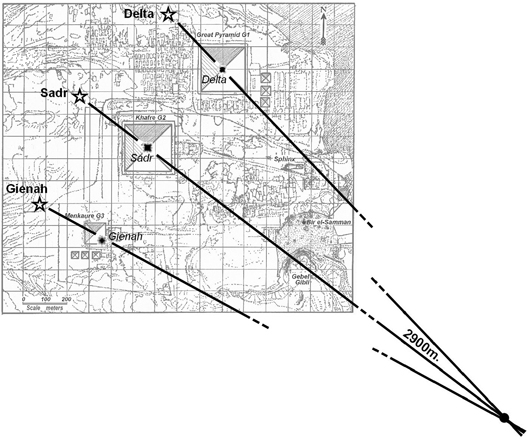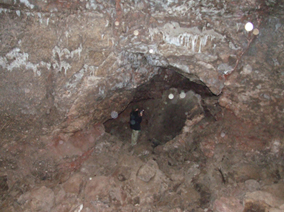| |
![]()
EARTHQUEST
NEWS
Andrew Collins Newsletter Vol. 12 No. 2(August 2009)
i.
Egypt's Lost Underworld Rediscovered
Sue
Collins inside Giza's previously unseen
cave complex (strict copyright Andrew
Collins, 2008)
In
March 2008 a exploration team, led by myself, Andrew Collins, discovered a massive
underground complex of caves, passageways and compartments in the limestone bedrock
beneath the pyramid field at Giza. Its existence had gone unnoticed since it was
last mentioned in the memoirs of a British diplomat and explorer nearly 200 years
ago. There is untouched archaeology down there, as well as a delicate eco-system
that includes colonies of bats and a species of spider tentatively identified
as the white widow. The caves are also said to be haunted by a mythical snake
called el-Hanash.
In 2007 Sue Collins and I, with the help of British Egyptological
researcher Nigel Skinner-Simpson, investigated an apparently unrecorded tomb west
of the Great Pyramid, its only mention coming from a diary entry by the British
explorer Col. Howard Vyse and his colleague, the British engineer, John Shae Perring.
He records how in 1837 they explored the tomb, removing from its interior the
mummy of a large bird. This and other indications in John Perring's subsequent
plan of the plateau indicate that the tomb, with its various underground compartments,
had been the focus of a local bird cult, either that of the falcon god Horus,
the son of Hathor, or, more likely, Sokar, another falcon-headed deity. He was
associated directly with Giza in its role as Rostau, the name given to the entrance
of an underworld realm called the Duat, a theme found in various ancient Egyptian
funerary texts and reflected in the modern-day belief that existing beneath the
Sphinx is the entrance to a hidden chamber known as the Hall of Records. According
to the readings of American psychic Edgar Cayce (1877-1945), this subterranean
structure contains the life records of those belonging to a lost civilization
that thrived at Giza at the end of the last Ice Age, c. 11,000-10,000 BC.
The
Cygnus Connection
| The reason why we had taken such an interest in this particular tomb, which we dubbed the Tomb of the Birds, was that it fell relatively close to a spot on the plateau marking the approximate position of an important star in a ground-sky relationship proposed by my colleague Rodney Hale. It involved the constellation of Cygnus, the celestial swan of classical mythology, known more popularly as the Northern Cross. This is located in the northern night sky where the Milky Way splits to become two parallel streams either side of a long dark area devoid of any stars called the Cygnus Rift. |  The sky-goddess Nuit as the Milky Way. Note the proximity of the Cygnus stars to her womb, navel and vulva (Copyright Andrew Collins/Rodney Hale). |
Universally, this area of the sky has been seen as a place of cosmic creation, as well as an entrance to a sky-world, where life originates and will ultimately return in death. In Egyptian star lore, Cygnus marked the position of the womb, navel and vulva of a sky-goddess named Nuit. She was the mother of Osiris, the god of the underworld, with whom every pharaoh was associated in death. His mythical tomb, on which all other royal tombs are thought to be designed, was in fact a symbolic chamber of rebirth, conceived as representing the divine womb of Nuit. Here the soul of the deceased would begin the process of transformation into an akh, a glorious spirit, at one with the stars. The tomb of Osiris was said to exist within an age-old mound or island of creation (another symbolic womb) somewhere north of Memphis, the Old Kingdom capital in Lower (or northern) Egypt, in the vicinity of Giza-Rostau.
Track of Cygnus's three wings stars as they set down into the Pyramids of Giza, c. 2500 BC | Rodney Hale had noticed that the three Pyramids of Giza accurately mimic the astronomical positions of three key stars in Cygnus. Moreover, from a position southeast of the plateau during the Pyramid age the same three stars could have been seen to set down each night into their respective pyramids. All this appears to lend support to the ancient Egyptian belief that Giza-Rostau acted as a physical representation of the Duat, which was conceived of as the body of the sky-goddess Nuit. |
She was said to nightly swallow the sun and then give birth to it again the following morning. Dr Robin Wells, an American astronomer working in the field of Egyptology, has associated the symbolic rebirth of the sun from Nuit's body with the constellation of Cygnus. Dr Amanda-Alice Maravelia of the Center for Egyptian Studies at the Russian Academy of Sciences (RAS), Moscow, has recently affirmed the link between Cygnus, the Milky Way and the body of Nuit in a ground-breaking paper entitled "Cosmic Space and Archetypal Time: Depictions Of The Sky-Goddess", available in PDF format by clicking here.

Tomb
of the Birds
Yet one key star of Cygnus remained unaccounted for in
Hale's ground-sky relationship, and this was Deneb, the constellation's brightest
star. It fell west of the Great Pyramid within the so-called western cemetery,
so its presence there had to mean something. So when I learned that Vyse and Perring
had found in the very same area a probable bird cemetery, sacred perhaps to a
local bird cult, I sought out the tomb in question.
Sue Collins and I investigated
the site in January 2007, but initially found nothing of any special interest.
We returned home, and the matter was left until I received a plan of the plateau
from Rodney Hale in which he outlined the pyramid field's underlying geometry.
This locked together the three main pyramids and Sphinx monument, yet also highlighted
an apparent significance in the area around what we had come to refer to as the
Tomb of the Birds.
So why was this site so important? Was there something
to be found here, underground perhaps? The answer came when Nigel found reference
to an underground system of "catacombs" investigated at Giza in 1817
by the British consul general Henry Salt. In the company of Italian explorer Giovanni
Caviglia he explored them for a distance of "several hundred yards"
before coming upon a large chamber that connected with three others of equal dimensions.
Yet having found no gold or treasure, Salt left Caviglia to explore further. The
Italian investigated one of a number of "labyrinthick" passages that
headed off into the darkness, but after journeying for just a few hundred feet
further he too gave up and returned to the surface.
The whole thing is
described in Salt's memoirs, kept in the British Museum. Although catalogued,
their greater significance was only realized upon their rediscovery in 2002. Following
their publication five years later in 2007, Nigel painstakingly reconstructed
the explorations undertaken on the plateau by Salt and Caviglia. Eventually he
pinned down the entrance to the lost catacombs as located immediately west of
the Great Pyramid. To our amazement we found that the area in question included
the Tomb of the Birds.
Having become convinced that the entrance to the
catacombs was via the Tomb of the Birds, we made plans to explore this area of
the plateau in greater detail. I also sought the support of the Association for
Research and Enlightenment (ARE), the research wing of the Edgar Cayce Foundation
in Virginia Beach, VA. They agreed
to help sponsor the expedition, which finally
got under way in early 2008.
We returned to the Tomb of the Birds on March
8th, and examined its every wall and crevice. Having found nothing at all we readied
ourselves to explore two further tombs in the vicinity. It was then that we noticed
a crack in the rock, which on peering through offered a quite wonderful sight.
It was the opening chamber into a massive natural cave, filled with fallen rock
debris. From this interior now came dozens of bats, no doubt disturbed by this
rude intrusion into their environment. However, I knew I couldn't turn back, and
so entered the catacombs and explored one cave tunnel for a distance of perhaps
80 meters. The whole complex was unquestionably natural, having been carved by
the actions of water tens of thousands, if not hundreds of thousands of years
ago, and much later enhanced, here and there, by human hands.

Andrew Collins inside the Kafr el-Hanash cave system at Giza
On
subsequent visits to the tomb, our team penetrated the caves to a much greater
depth, in the knowledge that we were following in the footsteps of Salt and Caviglia,
who had investigated these catacombs some 200 years earlier. The caves are, seemingly,
uncharted. They are highly dangerous, with unseen pits and hollows, colonies of
bats and a species of venomous spider tentatively identified as the white widow.
On top of this is the constant fear of oxygen starvation, which can be fatal,
and the prospect of airborne diseases carried by guano, bat droppings, which is
everywhere inside the caves. What we recorded, before we too suffered the first
symptoms of oxygen starvation, and how it relates to both the Duat and the Hall
of Records is fully explored in a new book I have written entitled Beneath the
Pyramids, published by Fourth Dimension Press in September 2009 (it will be available
in the UK in November-December 2009). The reason for revealing all this information
now is that there is already an enormous amount of chatter regarding the discoveries
online. Some of this suggests that the whole thing is either a complete fabrication,
or that what has been discovered is something mundane made out to be something
that it's not.
I can assure you that the discoveries are real. In the book
I outline the reaction to the existence of the caves by the Egyptian authorities,
who, as might be expected, have claimed they knew about them all along, even though
no supporting evidence has so far been provided. Nigel Skinner-Simpson has scoured
academic libraries in both Egypt and the UK looking for modern references to the
Tomb of the Birds and its associated natural cave system. Yet we have found nothing,
just vague rumours of early nineteenth century travellers witnessing bird mummies
being removed from a now lost necropolis, which might or might not be our tomb.
If you know anything yourself, feel free to contact me. It is a subject that I
suspect is going to run and run, and I will bring you news updates in future newsletters.
Bringing
to Life Egypt's Underworld
From the direction of the underlying geology,
it is clear that Giza'a subterranean realm reaches the main pyramid field before
disappearing beneath Giza's southern hill, known as Gebel Gibli. This rocky knoll,
we suspect, constitutes the original datum point, or survey point, from which
the pyramid field took shape. I believe also that the hill was seen as a representation
of the primeval mound, a place of first creation in the physical world, an attribution
preserved even today in a name given to the site in Arab Egyptian folklore. This
is Tarfaya, which means the "first place", or the "place of beginning",
in that it existed before everything else.
A previously unrecorded Arab
Egyptian legend uncovered by the author speaks of the caves beneath the plateau
as being guarded by a mythical snake named el-Hanash, described as thirty feet
(nine meters) in length. He protects a great diamond that contains the essence
of this deep underground place, and will blind anyone who attempts to steal the
jewel it protects. Yet one day someone, a chosen one, will come along and el-Hanash
will blind them only in one eye. It will be this person who goes on to access
the great jewel and learn of its secrets.
There is a core to this legend
that I believe is very ancient indeed, and relates to the existence in Giza's
chamber of first creation of a power object very similar to the lingams of Hindu
tradition, and the baetyls and omphali once found in the holy of holies of temples
across the Near East. Ancient Egyptian building texts on the walls of the temple
of Edfu in southern Egypt speak of Giza's underworld realm, named here as the
Underworld of the Soul (duat n ba), as not only containing the mythical tomb of
Osiris, but also a power object known as the bnnt (pronounced "bennet"),
a word meaning "seed" or "embryo".
A separate tradition
links this chamber with a power object called the benben-stone, a representation
of which was once to be seen at Heliopolis, the ancient cult center of the sun-god
Re situated just beyond what is today the city of Cairo. Such ideas might one
day be verified through a proper investigation of Giza's rediscovered underworld,
the mysteries of which I reveal for the first time in Beneath the Pyramids.

To
buy BENEATH THE PYRAMIDS, Andrew's new book on the quest to find Giza's cave underworld,
from Amazon click here.
To
buy straight from the publisher, 4th Dimension Press, click here.
Secure
the special edition of BENEATH THE PYRAMIDS signed, numbered and stamped direct
from the author by clicking here and sending
an email with "Beneath the Pyramids" in the contents box (with no final
obligation to buy).
Listen
to an exclusive interview with me on the discoveries beneath the plateau on the
Philip Coppens website by clicking here.
![]()
| |
